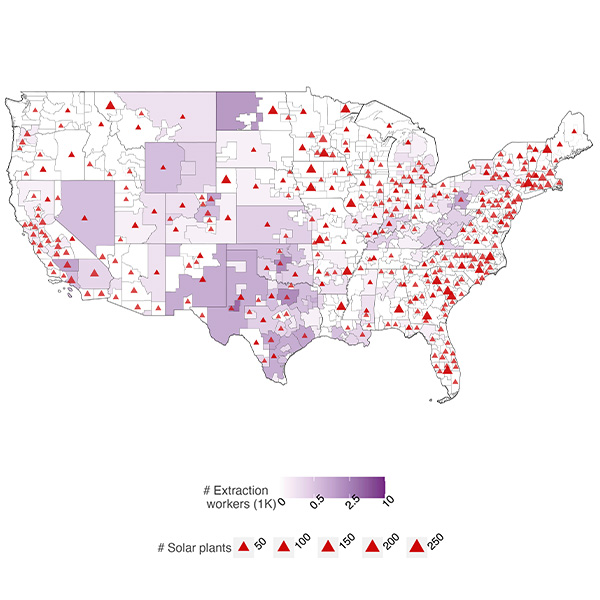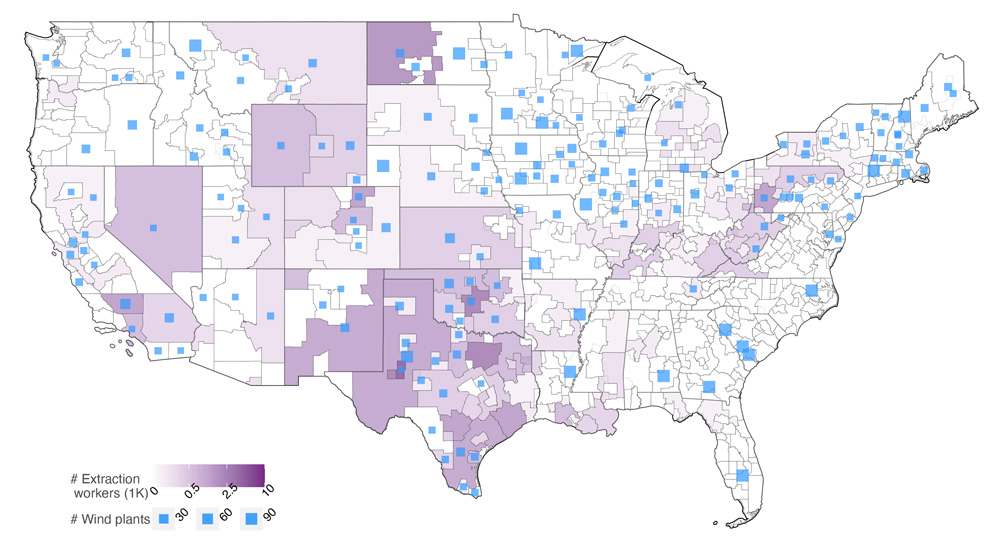
Green jobs may be growing, but the vast majority of the 1.7 million fossil fuel extraction workers whose jobs are threatened by the energy transition will not fill them, according to a new paper in the journal Nature Communications.
Authors Junghyun Lim, Michaël Aklin and Morgan Frank found a significant mismatch between where green jobs are being created and where fossil fuel extraction workers are located and little likelihood of many relocating for those green jobs, even when skill sets match.
“The vast majority of extraction workers (98.97%) will not transition to green jobs according to our model,” they found. Even in two idealized scenarios — one where all the green jobs are co-located with fossil fuel jobs and the other where fossil fuel workers’ skills match green occupations’ skills exactly — only 13.7% and 5.5% of extraction workers respectively will transition to green jobs. “While both skill similarity and spatial distance play important roles, geospatial distance is the primary barrier to transitions,” they wrote.
Their study analyzed power plant data from the U.S. Energy Information Administration, job transition data from the Census Bureau and employment and skills data from the Bureau of Labor Statistics to look at whether those fossil fuel workers were likely to benefit from the growth in green jobs. While the study looked at green jobs in general, it also compared worker locations with two large green job sources, solar and wind plants, and found wind-related jobs were a little more likely to be close to fossil fuel workers’ current locations.
Is a Just Transition Possible?
The term “Just Transition” entered the public discourse as the energy sector began moving from fossil fuel-based energy to solar, wind and other low- and zero-carbon energy sources. The International Labour Organization defines it as: “Greening the economy in a way that is as fair and inclusive as possible to everyone concerned, creating decent work opportunities and leaving no one behind.”
For the energy industry, it’s a question of what fossil fuel workers do if their jobs go away. The U.S. coal industry, which almost halved in size between 2012 and 2020 as fracking grew, shows the impact of an unjust transition. Coal workers who lost jobs had few other opportunities, leaving some already-struggling areas in Appalachia the most economically distressed in the country.
“Large-scale labor market transitions are notoriously costly and difficult to complete,” Lim, Aklin and Frank wrote. “Accordingly, workers, unions and policymakers are seeking a ‘Just Transition’ in which fossil fuel workers receive public support to find new jobs.”
Achieving a Just Transition takes more than simply creating enough green industry jobs. “The issue is more complicated than simply the total number of job opportunities that will be created,” the authors said. “To be successful, this transition requires a high degree of skill similarity and geographical congruence between green and fossil fuel jobs — in addition to solutions for other non-economic social barriers.”
The Biden administration has been focused on green jobs growth, most recently announcing the “American Climate Corps,” a New-Deal style plan to train 20,000 young people. However, the relocation barrier may demand a more nuanced approach to assist those with established careers in fossil fuel extraction. Policies could address the issue “either by creating incentives for today’s fossil fuel workers to relocate or by stimulating new employment opportunities in the regions where fossil fuel workers currently reside,” the authors said.
Some states face a larger mismatch than others: “Several regions within Great Plains states will have green employment that is comparable to their local fossil fuel employment in 2019,” they wrote, “However, many of the regions with the greatest number of fossil fuel workers, including regions in Nevada, New Mexico, Western Pennsylvania and North Dakota, will not experience comparable green job growth.” Skills were less problematic, however. Lim, Aklin and Frank found that “some re-skilling may be required even though fossil fuel workers’ skills are better matched to green occupations than to other industries.”

